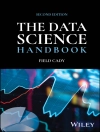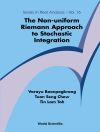The field of high-throughput genetic experimentation is evolving
rapidly, with the advent of new technologies and new venues for
data mining. Bayesian methods play a role central to the future of
data and knowledge integration in the field of Bioinformatics. This
book is devoted exclusively to Bayesian methods of analysis for
applications to high-throughput gene expression data, exploring the
relevant methods that are changing Bioinformatics. Case studies,
illustrating Bayesian analyses of public gene expression data,
provide the backdrop for students to develop analytical skills,
while the more experienced readers will find the review of advanced
methods challenging and attainable.
This book:
* Introduces the fundamentals in Bayesian methods of analysis for
applications to high-throughput gene expression data.
* Provides an extensive review of Bayesian analysis and advanced
topics for Bioinformatics, including examples that extensively
detail the necessary applications.
* Accompanied by website featuring datasets, exercises and
solutions.
Bayesian Analysis of Gene Expression Data offers a unique
introduction to both Bayesian analysis and gene expression, aimed
at graduate students in Statistics, Biomedical Engineers, Computer
Scientists, Biostatisticians, Statistical Geneticists,
Computational Biologists, applied Mathematicians and Medical
consultants working in genomics. Bioinformatics researchers from
many fields will find much value in this book.
Содержание
Table of Notation.
1 Bioinformatics and Gene Expression Experiments.
1.1 Introduction.
1.2 About This Book.
2 Basic Biology.
2.1 Background.
2.1.1 DNA Structures and Transcription.
2.2 Gene Expression Microarray Experiments.
3 Bayesian Linear Models for Gene Expression.
3.1 Introduction.
3.2 Bayesian Analysis of a Linear Model.
3.3 Bayesian Linear Models for Differential Expression.
3.4 Bayesian ANOVA for Gene Selection.
3.5 Robust ANOVA model with Mixtures of Singular Distributions.
3.6 Case Study.
3.7 Accounting for Nuisance Effects.
3.8 Summary and Further Reading.
4 Bayesian Multiple Testing and False Discovery Rate Analysis.
4.1 Introduction to Multiple Testing.
4.2 False Discovery Rate Analysis.
4.3 Bayesian False Discovery Rate Analysis.
4.4 Bayesian Estimation of FDR.
4.5 FDR and Decision Theory.
4.6 FDR and b FDR Summary.
5 Bayesian Classification for Microarray Data.
5.1 Introduction.
5.2 Classification and Discriminant Rules.
5.3 Bayesian Discriminant Analysis.
5.4 Bayesian Regression Based Approaches to Classification.
5.5 Bayesian Nonlinear Classification.
5.6 Prediction and Model Choice.
5.7 Examples.
5.8 Discussion.
6 Bayesian Hypothesis Inference for Gene Classes.
6.1 Interpreting Microarray Results.
6.2 Gene Classes.
6.3 Bayesian Enrichment Analysis.
6.4 Multivariate Gene Class Detection.
6.5 Summary.
7 Unsupervised Classification and Bayesian Clustering.
7.1 Introduction to Bayesian Clustering for Gene Expression Data.
7.2 Hierarchical Clustering.
7.3 K-Means Clustering.
7.4 Model-Based Clustering.
7.5 Model-Based Agglomerative Hierarchical Clustering.
7.6 Bayesian Clustering.
7.7 Principal Components.
7.8 Mixture Modeling.
7.8.1 Label Switching.
7.9 Clustering Using Dirichlet Process Prior.
7.9.1 Infinite Mixture of Gaussian Distributions.
8 Bayesian Graphical Models.
8.1 Introduction.
8.2 Probabilistic Graphical Models.
8.3 Bayesian Networks.
8.4 Inference for Network Models.
9 Advanced Topics.
9.1 Introduction.
9.2 Analysis of Time Course Gene Expression Data.
9.3 Survival Prediction Using Gene Expression Data.
Appendix A: Basics of Bayesian Modeling.
A.1 Basics.
A.1.1 The General Representation Theorem.
A.1.2 Bayes’ Theorem.
A.1.3 Models Based on Partial Exchangeability.
A.1.4 Modeling with Predictors.
A.1.5 Prior Distributions.
A.1.6 Decision Theory and Posterior and Predictive Inferences.
A.1.7 Predictive Distributions.
A.1.8 Examples.
A.2 Bayesian Model Choice.
A.3 Hierarchical Modeling.
A.4 Bayesian Mixture Modeling.
A.5 Bayesian Model Averaging.
Appendix B: Bayesian Computation Tools.
B.1 Overview.
B.2 Large-Sample Posterior Approximations.
B.2.1 The Bayesian Central Limit Theorem.
B.2.2 Laplace’s Method.
B.3 Monte Carlo Integration.
B.4 Importance Sampling.
B.5 Rejection Sampling.
B.6 Gibbs Sampling.
B.7 The Metropolis Algorithm and Metropolis-Hastings.
B.8 Advanced Computational Methods.
B.8.1 Block MCMC.
B.8.2 Truncated Posterior Spaces.
B.8.3 Latent Variables and the Auto-Probit Model.
B.8.4 Bayesian Simultaneous Credible Envelopes.
B.8.5 Proposal Updating.
B.9 Posterior Convergence Diagnostics.
B.10 MCMC Convergence and the Proposal.
B.10.1 Graphical Checks for MCMC Methods.
B.10.2 Convergence Statistics.
B.10.3 MCMC in High-Throughput Analysis.
B.11 Summary.
References.
Index.
Об авторе
Bani Mallick, Department of Statistics, Texas A&M
University, USA.
Veera Balandandayuthapani, Department of Biostatistics,
Anderson Cancer Center, Texas, USA.
David L. Gold, Department of Biostatistics, School of Public
Health and Health Professions, University at Buffalo, The State
University of New York, USA.












